2021-2022学年 Unit6 I'm watching TV. Section A 1a-2d 课件32张
文档属性
| 名称 | 2021-2022学年 Unit6 I'm watching TV. Section A 1a-2d 课件32张 | 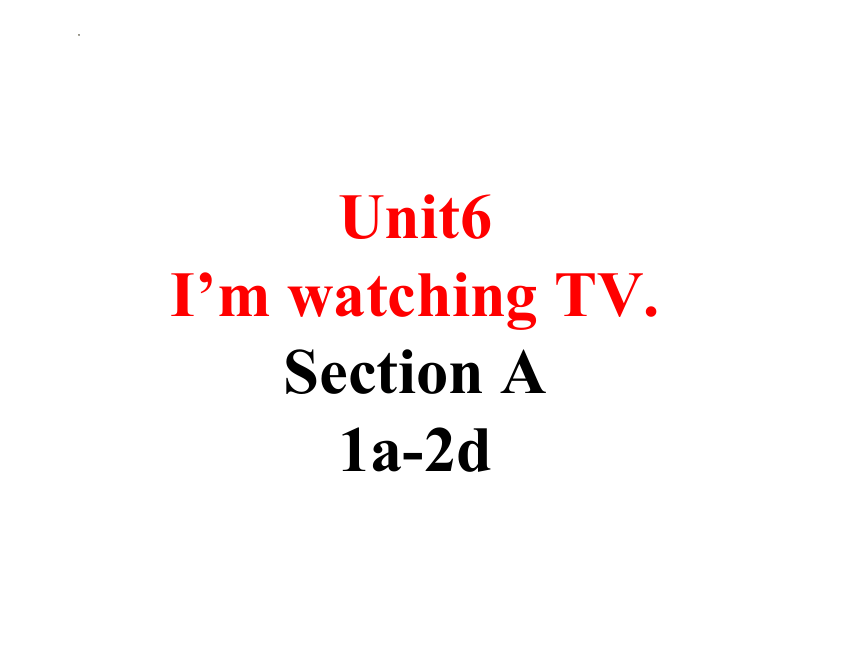 | |
| 格式 | pptx | ||
| 文件大小 | 1.8MB | ||
| 资源类型 | 教案 | ||
| 版本资源 | 人教新目标(Go for it)版 | ||
| 科目 | 英语 | ||
| 更新时间 | 2022-04-14 14:26:51 | ||
图片预览

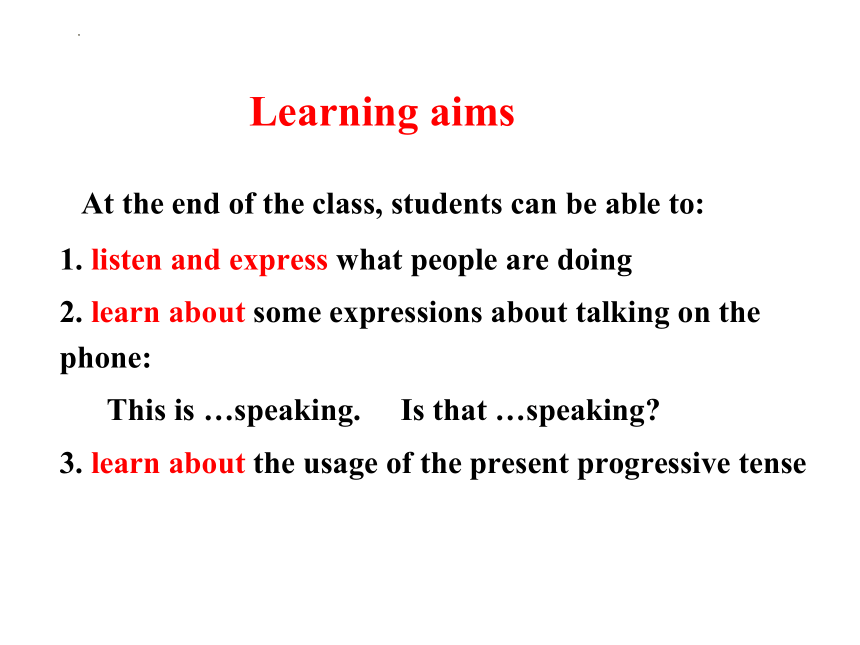
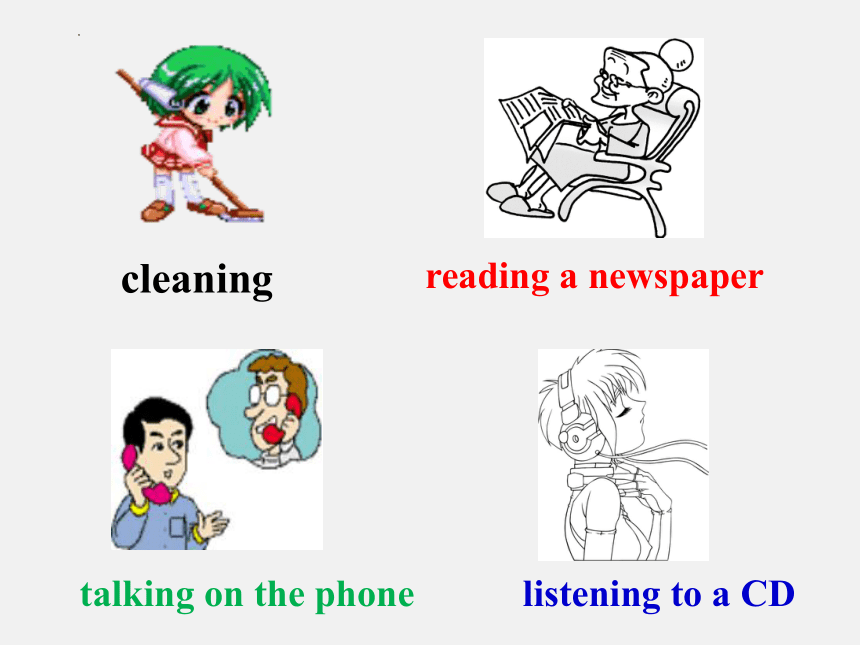
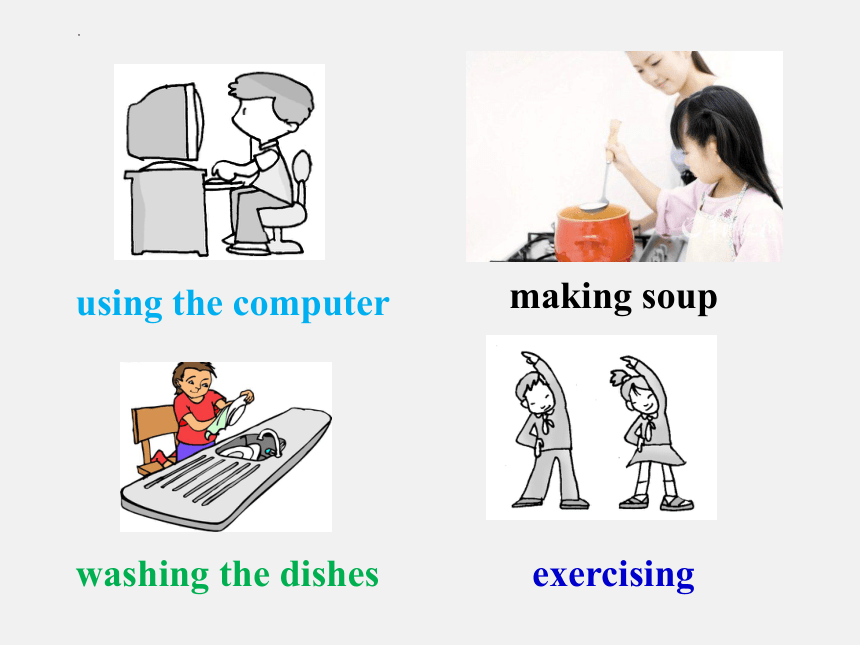
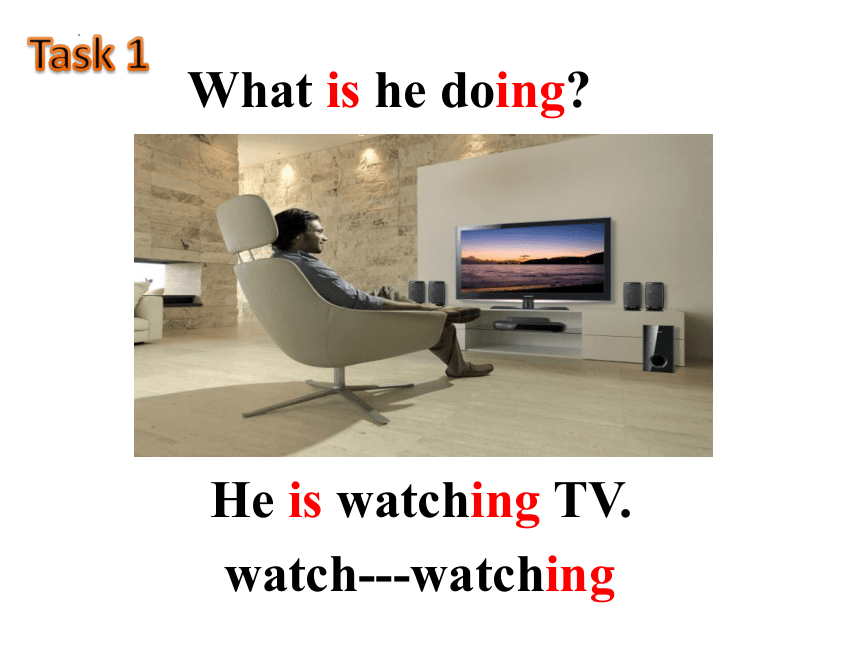
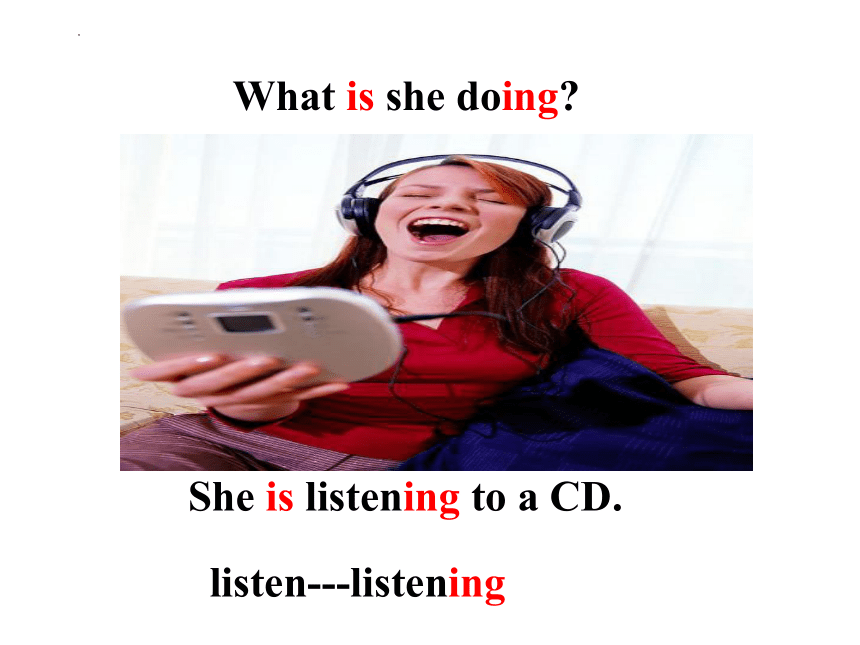
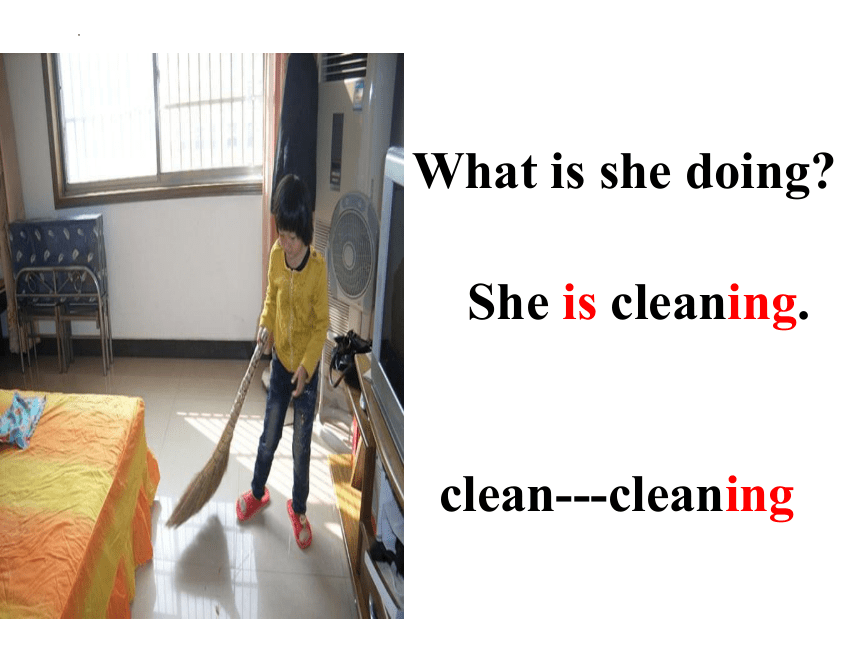
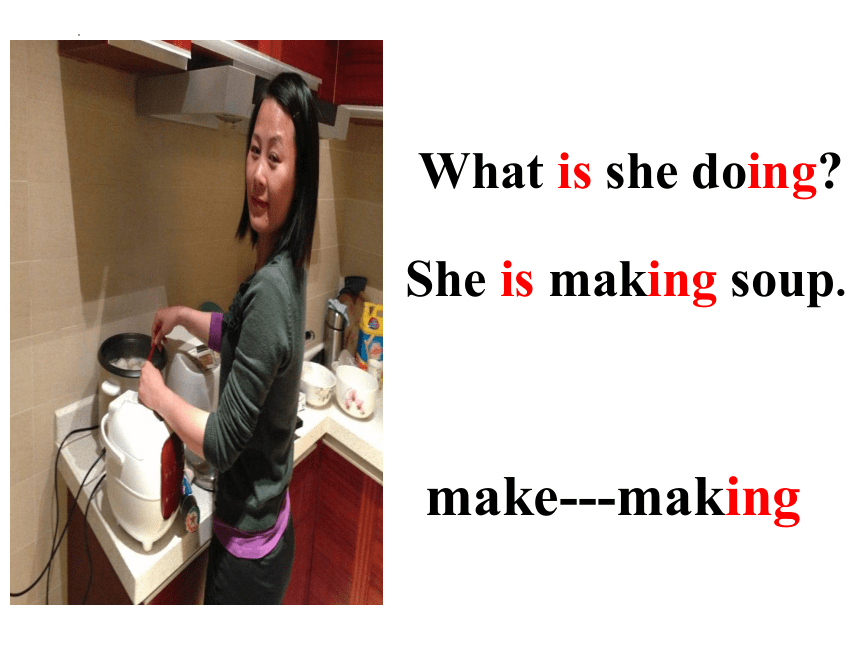
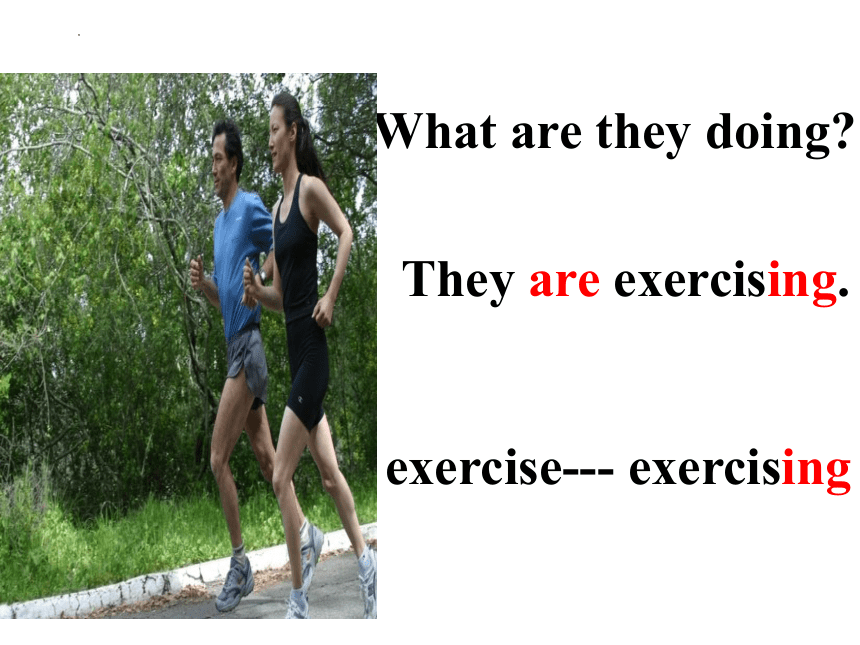
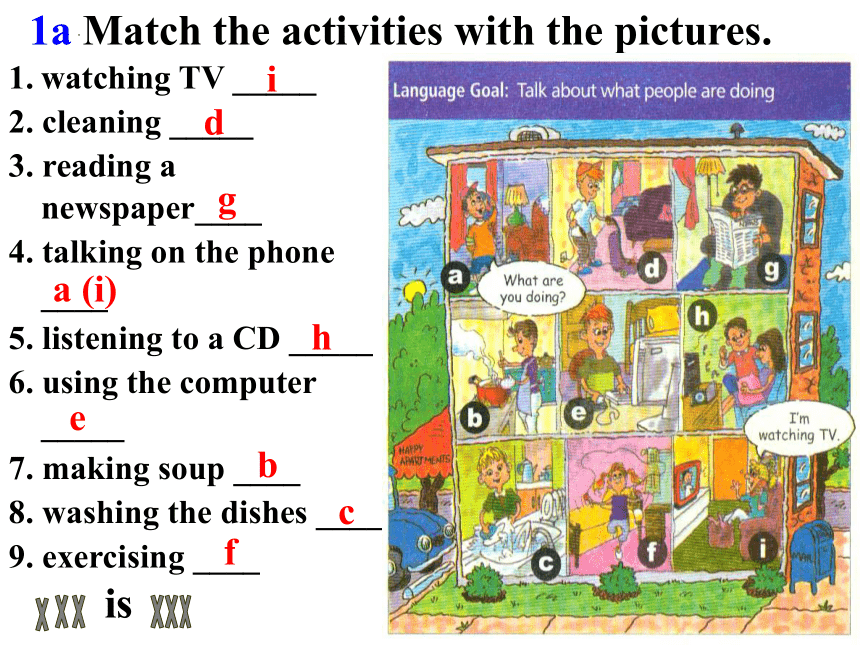


文档简介
(共32张PPT)
Unit6
I’m watching TV.
Section A
1a-2d
Learning aims
At the end of the class, students can be able to:
1. listen and express what people are doing
2. learn about some expressions about talking on the phone:
This is …speaking. Is that …speaking
3. learn about the usage of the present progressive tense
cleaning
listening to a CD
reading a newspaper
talking on the phone
exercising
making soup
washing the dishes
using the computer
What is he doing
He is watching TV.
watch---watching
Task 1
She is listening to a CD.
What is she doing
listen---listening
She is cleaning.
What is she doing
clean---cleaning
What is she doing
She is making soup.
make---making
They are exercising.
What are they doing
exercise--- exercising
1a Match the activities with the pictures.
watching TV _____
2. cleaning _____
3. reading a newspaper____
4. talking on the phone ____
5. listening to a CD _____
6. using the computer _____
7. making soup ____
8. washing the dishes ____
9. exercising ____
i
d
g
a (i)
h
e
b
c
f
is
Name doing
Jenny
watching TV
1b Listen. What are these people doing Write the numbers from 1a.
washing the dishes
listening to a CD
John
Dave and Mary
a. Jenny ___
b. John ___
c. Dave and Mary ___
1
8
5
running
Guessing Game
What’s he/she doing He/she is …
What are they doing They’re…
drawing
dancing
三人一组,一,两人做动作让另外的两人(A和B)对话.
A:What is she/he doing
B:She/He is...
Pairwork
如:doing homework, reading,dancing, swimming等学过的动词,注意要用be doing 结构噢。
Task 4
A:What are they doing
B:They are…
dancing
swimming
singing
drawing
teaching English
playing the guitar
-What’s he/she doing -He/She is V-ing.
eating an apple
2a
1. What is Steve
doing
2. What is Jack
doing
a. He is watching TV.
b. He is listening to a
CD.
Listen and match the answers
with the questions.
Jack: Hello, Steve.
Steve: Hi, Jack.
Jack: What ________ you ________, Steve
Steve: I’m ______________. What about you
Jack: I’m ________________, but it’s kind of ________.
Steve: Yeah, my TV show is also not very _________. Do you want to ______ the movies
Jack: That sounds good.
are
doing
watching TV
listening to a CD
boring
interesting
go to
2b
Listen again. Fill in the blanks.
2c
Role-play the conversation in 2b.
2d
Role-play the conversation.
Jenny: Hello This is Jenny.
Laura: Hi, Jenny. It’s Laura here.
Jenny: Oh, hi, Laura. What are you doing
Laura: Not much. I’m just washing my clothes. What about you
Jenny: I’m watching TV. Do you want to join me for dinner My parents aren’t at home. We can eat out.
Laura: Yeah. I’d love to.
Jenny: Let’s meet at my home e at half past six.
Laura: OK. See you then.
Jenny: What are you doing
珍尼:你在干什么呢?(你忙什么呢 )
Laura: Not much.
劳拉:没忙什么。
Not much是用做回答的交际套语,还可说成 Nothing much, 相当于汉语“不忙什么;没什么事”,表示自己有空。例如:
A:What are you doing this evening
你今晚要做什么事?
B:Well, nothing much.
嗯,没什么事。
Language points
2. Do you want to join me for dinner
你想跟我一起吃个饭吗?
join somebody for something 表示“与某人一起做某事;参与或加入到某人的行列中一起做某事”。例如:
Would you come and join us for a cup of coffee We need to talk to you.
你来跟我们喝杯咖啡好吗? 我们要跟你谈一谈。
join 指加入某党派、某组织或某社会团体,以及参军等,还可表示参与某种活动。
例句:
I will never forget the day when I joined the Party.
我永远也忘不了入党的那一天。
join in 通常指参加某种活动,尤其指和其他人一起参加某项活动。例句:
May I join in the game
我可以参加这个比赛吗?
用 join 和 join in 的适当形式填空。
1. We are playing football. Do you want to __________
2. You are welcome to _________ us.
3. He is against letting girls ________ the club.
join in
join
join
3. I’d love to.
我很乐意。
1) 作为一个交际应答套语,I’d love to 经常用于礼貌地接受他人邀请,还可说成I’d like to, 但语气较前者稍弱。例如:
A:Would you like to come with us to the show
你愿意跟我们一起去看表演吗?
B:Thanks. I’d like to.
多谢了,我可以的。
2) 当婉言拒绝他人邀请时,英语多用I’d love to, but … 或Sorry, I’m afraid I can’t because …等。例如:
A:I’m going to town. Would you like to join me
我进城去,你想跟我一同去吗?
B:Sorry, I’m afraid I can’t because I still have lots of homework to do.
真抱歉,恐怕我去不成,我还有好多作业要做。
现在进行时态
1. 定义:表示现在正在进行的动作。
2. 构成:am( is, are) + 动词的现在分词
The Present Continuous Tense
动词现在分词的构成规律
1) 一般情况下,在动词原形后直接加-ing。如:
work—working do—doing play—playing
2) 以不发音的字母e结尾的动词,去掉e,再加-ing. 如:
dance—dancing come—coming
3) 重读闭音节单词,如果末尾只有一个辅音字母,则双写这一字母,再加-ing。如:
get—getting shop—shopping
run—running swim—swimming
根据句意及汉语提示写单词。
1.It (恰好)takes ten minutes to clean the room.
2.Let's go to see a (电影)on Sunday.
3.Mary has to (洗)her clothes on weekends.
4.It's half (过)five.They are playing basketball.
5.That (听起来)good.
just
movie
wash
past
sounds
单项选择。
1.—Hello! Peter.
—Hello!Peter!It's Mike here.
A.I am B.This is C.That is
2.—Where's Tom
—He newspapers at home.
A.read B.reads
C.is reading
3.—Let's go to the movies.
—That great.The TV show is boring.
A.looks B.sounds C.hear
B
C
B
4.—What are you doing,Linda
— .I'm just watching TV.
A.A lot of things
B.Not much
C.Reading a book
5.—What is Mom doing now
—She some dishes.
A.washes
B.washing
C.is washing
B
C
1.Look, Mr. Wu __________ ( play ) football.
2.---Where is Li Lei
--- He ___________ ( water) trees in the garden.
3. The baby __________ ( sleep ).
4. Look! A dog ___________ ( run ) after a cat.
用动词适当形式填空:
is playing
is watering
is sleeping
is running
5. The boy _______ ( take) photos now.
6.Listen ,some girls ________ ( sing) in the classroom .
7. The old man __________ ( lie )in the sun now.
8. What _____ you ______ ( do ) now
9.They ________ (not ,water) the flowers now.
is taking
are singing
is lying
are
doing
aren’t watering
Unit6
I’m watching TV.
Section A
1a-2d
Learning aims
At the end of the class, students can be able to:
1. listen and express what people are doing
2. learn about some expressions about talking on the phone:
This is …speaking. Is that …speaking
3. learn about the usage of the present progressive tense
cleaning
listening to a CD
reading a newspaper
talking on the phone
exercising
making soup
washing the dishes
using the computer
What is he doing
He is watching TV.
watch---watching
Task 1
She is listening to a CD.
What is she doing
listen---listening
She is cleaning.
What is she doing
clean---cleaning
What is she doing
She is making soup.
make---making
They are exercising.
What are they doing
exercise--- exercising
1a Match the activities with the pictures.
watching TV _____
2. cleaning _____
3. reading a newspaper____
4. talking on the phone ____
5. listening to a CD _____
6. using the computer _____
7. making soup ____
8. washing the dishes ____
9. exercising ____
i
d
g
a (i)
h
e
b
c
f
is
Name doing
Jenny
watching TV
1b Listen. What are these people doing Write the numbers from 1a.
washing the dishes
listening to a CD
John
Dave and Mary
a. Jenny ___
b. John ___
c. Dave and Mary ___
1
8
5
running
Guessing Game
What’s he/she doing He/she is …
What are they doing They’re…
drawing
dancing
三人一组,一,两人做动作让另外的两人(A和B)对话.
A:What is she/he doing
B:She/He is...
Pairwork
如:doing homework, reading,dancing, swimming等学过的动词,注意要用be doing 结构噢。
Task 4
A:What are they doing
B:They are…
dancing
swimming
singing
drawing
teaching English
playing the guitar
-What’s he/she doing -He/She is V-ing.
eating an apple
2a
1. What is Steve
doing
2. What is Jack
doing
a. He is watching TV.
b. He is listening to a
CD.
Listen and match the answers
with the questions.
Jack: Hello, Steve.
Steve: Hi, Jack.
Jack: What ________ you ________, Steve
Steve: I’m ______________. What about you
Jack: I’m ________________, but it’s kind of ________.
Steve: Yeah, my TV show is also not very _________. Do you want to ______ the movies
Jack: That sounds good.
are
doing
watching TV
listening to a CD
boring
interesting
go to
2b
Listen again. Fill in the blanks.
2c
Role-play the conversation in 2b.
2d
Role-play the conversation.
Jenny: Hello This is Jenny.
Laura: Hi, Jenny. It’s Laura here.
Jenny: Oh, hi, Laura. What are you doing
Laura: Not much. I’m just washing my clothes. What about you
Jenny: I’m watching TV. Do you want to join me for dinner My parents aren’t at home. We can eat out.
Laura: Yeah. I’d love to.
Jenny: Let’s meet at my home e at half past six.
Laura: OK. See you then.
Jenny: What are you doing
珍尼:你在干什么呢?(你忙什么呢 )
Laura: Not much.
劳拉:没忙什么。
Not much是用做回答的交际套语,还可说成 Nothing much, 相当于汉语“不忙什么;没什么事”,表示自己有空。例如:
A:What are you doing this evening
你今晚要做什么事?
B:Well, nothing much.
嗯,没什么事。
Language points
2. Do you want to join me for dinner
你想跟我一起吃个饭吗?
join somebody for something 表示“与某人一起做某事;参与或加入到某人的行列中一起做某事”。例如:
Would you come and join us for a cup of coffee We need to talk to you.
你来跟我们喝杯咖啡好吗? 我们要跟你谈一谈。
join 指加入某党派、某组织或某社会团体,以及参军等,还可表示参与某种活动。
例句:
I will never forget the day when I joined the Party.
我永远也忘不了入党的那一天。
join in 通常指参加某种活动,尤其指和其他人一起参加某项活动。例句:
May I join in the game
我可以参加这个比赛吗?
用 join 和 join in 的适当形式填空。
1. We are playing football. Do you want to __________
2. You are welcome to _________ us.
3. He is against letting girls ________ the club.
join in
join
join
3. I’d love to.
我很乐意。
1) 作为一个交际应答套语,I’d love to 经常用于礼貌地接受他人邀请,还可说成I’d like to, 但语气较前者稍弱。例如:
A:Would you like to come with us to the show
你愿意跟我们一起去看表演吗?
B:Thanks. I’d like to.
多谢了,我可以的。
2) 当婉言拒绝他人邀请时,英语多用I’d love to, but … 或Sorry, I’m afraid I can’t because …等。例如:
A:I’m going to town. Would you like to join me
我进城去,你想跟我一同去吗?
B:Sorry, I’m afraid I can’t because I still have lots of homework to do.
真抱歉,恐怕我去不成,我还有好多作业要做。
现在进行时态
1. 定义:表示现在正在进行的动作。
2. 构成:am( is, are) + 动词的现在分词
The Present Continuous Tense
动词现在分词的构成规律
1) 一般情况下,在动词原形后直接加-ing。如:
work—working do—doing play—playing
2) 以不发音的字母e结尾的动词,去掉e,再加-ing. 如:
dance—dancing come—coming
3) 重读闭音节单词,如果末尾只有一个辅音字母,则双写这一字母,再加-ing。如:
get—getting shop—shopping
run—running swim—swimming
根据句意及汉语提示写单词。
1.It (恰好)takes ten minutes to clean the room.
2.Let's go to see a (电影)on Sunday.
3.Mary has to (洗)her clothes on weekends.
4.It's half (过)five.They are playing basketball.
5.That (听起来)good.
just
movie
wash
past
sounds
单项选择。
1.—Hello! Peter.
—Hello!Peter!It's Mike here.
A.I am B.This is C.That is
2.—Where's Tom
—He newspapers at home.
A.read B.reads
C.is reading
3.—Let's go to the movies.
—That great.The TV show is boring.
A.looks B.sounds C.hear
B
C
B
4.—What are you doing,Linda
— .I'm just watching TV.
A.A lot of things
B.Not much
C.Reading a book
5.—What is Mom doing now
—She some dishes.
A.washes
B.washing
C.is washing
B
C
1.Look, Mr. Wu __________ ( play ) football.
2.---Where is Li Lei
--- He ___________ ( water) trees in the garden.
3. The baby __________ ( sleep ).
4. Look! A dog ___________ ( run ) after a cat.
用动词适当形式填空:
is playing
is watering
is sleeping
is running
5. The boy _______ ( take) photos now.
6.Listen ,some girls ________ ( sing) in the classroom .
7. The old man __________ ( lie )in the sun now.
8. What _____ you ______ ( do ) now
9.They ________ (not ,water) the flowers now.
is taking
are singing
is lying
are
doing
aren’t watering
同课章节目录
- Unit 1 Can you play the guitar?
- Section A
- Section B
- Unit 2 What time do you go to school?
- Section A
- Section B
- Unit 3 How do you get to school?
- Section A
- Section B
- Unit 4 Don't eat in class.
- Section A
- Section B
- Unit 5 Why do you like pandas?
- Section A
- Section B
- Unit 6 I'm watching TV.
- Section A
- Section B
- Review of Units 1-6
- Unit 7 It's raining!
- Section A
- Section B
- Unit 8 Is there a post office near here?
- Section A
- Section B
- Unit 9 What does he look like?
- Section A
- Section B
- Unit 10 I'd like some noodles.
- Section A
- Section B
- Unit 11 How was your school trip?
- Section A
- Section B
- Unit 12 What did you do last weekend?
- Section A
- Section B
